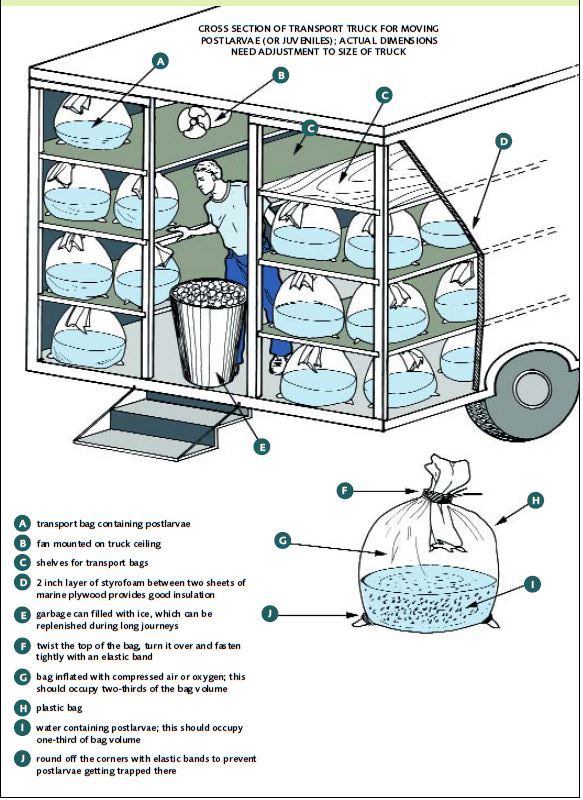5.3 Transporting postlarvae
Cooled and aerated fish transport tanks are ideal for transporting freshwater prawn postlarvae (PL) from the hatchery holding tanks to the pond site but they are rarely available or affordable. For journey times of up to one or two hours to the pond site, you can use aerated garbage cans. A 100 L trash can, holding 50 L of water, will hold 50 000 PL. You should insert baffles in the container to prevent excessive water movement during transport.
Larger, open plastic tanks (1 m3), containing about 500 L of aerated water, can hold about 500 000 PL during a short journey.
For longer distances you can use the method employed for transporting aquarium fish. Place them in double plastic bags containing 1/3 water and 2/3 air or oxygen (Figure 41).
You can put about 250-400 PL in each litre of water. A 45 x 80 cm bag holding 8 L of water, for example, will take 2 000-3 000 PL. Higher or lower transport densities are used by some hatcheries. It is suggested that, if you have not done this before, you carry out some simple experiments to determine the optimum density for your conditions (length and duration of journey, climatic conditions, etc.). Round off the corners of the bags with rubber bands to prevent animals getting trapped there. Twist the top of the bag and bend it over, sealing it tightly with a rubber band after you have inflated it with air or oxygen.
These inflated bags can be used to transport PL very long distances (up to at least 16 hours travelling time by road). If you put them into insulated ‘styrofoam’ boxes you can ship PL by air most effectively. If they are in non-insulated boxes you can send them on night (cool) journeys by rail, for example. For long day-time (hot) journeys, you can stack the plastic bags on shelves in a home-made transport box mounted on a truck. The transport truck (Figure 41) should be insulated. Place garbage cans filled with ice on the floor, to keep the temperature down.
Lowering temperature during transport reduces metabolic activity and improves survival. You should also use water from the holding tank to fill the plastic transport bags.
If you place the PL into ‘new’ water for transport, many will moult during the journey and many with be lost through cannibalism. Some hatcheries add a very small amount of seawater to the transport bags, claiming that survival rates are better in brackishwater than in freshwater. You can try this for yourself but remember that increasing salinity will lower
FIGURE41
Postlarvae in plastic bags can be transported long distances in modified trucks provided with shelves, a small fan, and simple cooling

SOURCE: EMANUELA D’ANTONI
the dissolved oxygen content of the water and, if extreme, may make it necessary to adjust the salinity again before stocking the animals in the rearing water. A transport temperature of about 20-25°C is recommended for journeys of less than 6 hours. Keep it down to 20-22°C for longer trips. A one ton truck can transport up to 500 000 PL in plastic bags.
You can keep the temperature steady throughout the truck by using electric fans driven from the truck engine or batteries. You can get very good transport survival in this way.
To facilitate stocking at the pond site it is normal to standardize the number of prawns in each transport bag. It is therefore necessary for you to estimate the quantity of PL as accurately as possible when the bags are filled (Annex 6). It is not necessary to be exactly accurate. The value of accuracy must be set against the losses of PL which would be caused by excessive handling. However, you must make reasonably accurate estimates because it is upon this figure that pond stocking and feeding rates will be based and charges for PL levied.
The survival rate of 7 day old (after metamorphosis) PL during shipping is much higher than 1 day old animals. It is not good practice to ship PL of widely different age groups. However, because of the method of larval culture, the age (post-metamorphosis) of the PL will inevitably vary by a day or two.